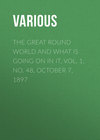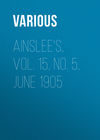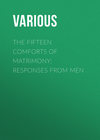Читать книгу: «Notes and Queries, Number 190, June 18, 1853», страница 5
SELLING A WIFE
(Vol. vii., p. 429.)
The popular idea that a man may legally dispose of his wife, by exposing her for sale in a public market, may not improbably have arisen from the correlation of the terms buying and selling. Your correspondent V. T. Sternberg need not be reminded how almost universal was the custom among ancient nations of purchasing wives; and he will admit that it appears natural that the commodity which has been obtained "per æs et libram"—to use the phrase of the old Roman law touching matrimony—is transferable to another for a similar consideration, whenever it may have become useless or disagreeable to its original purchaser. However this may be, the custom is ancient, and moreover appears to have obtained, to some extent, among the higher orders of society. Of this an instance may be found in Grimaldi's Origines Genealogicæ, pp. 22, 23. (London, 1828, 4to.) The deed, by which the transaction was sought to be legalised, runs as follows:
"To all good Christians to whom this writ shall come, John de Camoys, son and heir of Sir Ralph de Camoys, greeting: Know me to have delivered, and yielded up of my own free will, to Sir William de Paynel, Knight, my wife Margaret de Camoys, daughter and heiress of Sir John de Gatesden; and likewise to have given and granted to the said Sir William, and to have made over and quit-claimed all goods and chattels which the said Margaret has or may have, or which I may claim in her right; so that neither I, nor any one in my name, shall at any time hereafter be able to claim any right to the said Margaret, or to her goods and chattels, or their pertinents. And I consent and grant, and by this writ declare, that the said Margaret shall abide and remain with the said Sir William during his pleasure. In witness of which I have placed my seal to this deed, before these witnesses: Thomas de Depeston, John de Ferrings, William de Icombe, Henry le Biroun, Stephen Chamberlayne, Walter le Blound, Gilbert de Batecumbe, Robert de Bosco, and others."
This matter came under the cognisance of Parliament in 1302, when the grant was pronounced to be invalid.
Now, we may fondly believe that this transaction, which occurred five hundred and fifty years ago, was characteristic alone of that dark and distant period, and that no parallel can be found in modern times (at least in a decent class of society, and recognised by legal sanction) to justify the lively French dramatists in seizing upon it as a trait of modern English manners. A transaction, however, came before the public eye a month or two ago, which, should you think the following record of it worth preservation as a "curiosity of legal experience," may lead your readers to a different conclusion:
"A young man, named W. C. Capas, was charged at the Public Office, Birmingham, Jan. 31, 1853, with assaulting his wife. The latter, in giving her evidence, stated that her husband was not living with her, but was 'leased' to another female. Upon inquiry by the magistrate into this novel species of contract, the document itself was produced in court, and read. It ran as follows:
"'Memorandum of agreement made and entered into this second day of October, in the year of our Lord 1852, between William Charles Capas, of Charles-Henry Street, in the borough of Birmingham, in the county of Warwick, carpenter, of the one part, and Emily Hickson, of Hurst Street, Birmingham aforesaid, spinster, of the other part. Whereas the said William Charles Capas and Emily Hickson have mutually agreed with each other to live and reside together, and to mutually assist in supporting and maintaining each other during the remainder of their lives, and also to sign the agreement hereinafter contained to that effect: now, therefore, it is hereby mutually agreed upon, by and between the said William Charles Capas and Emily Hickson, that they the said, &c., shall live and reside together during the remainder of their lives, and that they shall mutually exert themselves by work and labour, and by following all their business pursuits, to the best of their abilities, skill, and understanding, and by advising and assisting each other, for their mutual benefit and advantage, and also to provide for themselves and each other the best supports and comforts of life which their means and income may afford. And for the true and faithful performance of this agreement, each of the said parties bindeth himself and herself unto the other finally by this agreement, as witness the hands of the said parties, this day and year first above written."
Here follow the signatures of the consenting parties. The girl Hickson was examined, and admitted that she had signed the document at the office of a Mr. Campbell, the lawyer(!) who prepared it, and that his charge for drawing up the same was, she believed, 1l. 15s. The latter promised her, at the same time, that if the wife of Capas gave her any annoyance he would put in that paper as evidence. The magistrates, considering the assault proved, fined Capas 2s. 6d., and "commented in very strong terms on the document which had that day been brought before them." (See Birmingham Journal, Jan. 5th, 1853.) Has a similar transaction come before the notice of your correspondents?
I may add that we are informed by the Birmingham Argus for March, 1834, that in that month a man led his wife by a halter to Smithfield Market in that town, and there publicly offered her for sale.
William Bates.
Birmingham.
ENOUGH
(Vol. vii., p. 455.)
This word, when written or pronounced enow, is regarded as a plural, and relates to number. In this sense it is employed in Northampton and other Midland counties, and is found in old writers. If the word was always pronounced enow, it must be long since. The distinction above hinted at prevailed in Waller's time, and he conforms to it in the examples quoted. Butler, in Hudibras, has both:
"This b'ing professed we hope enough,
And now go on where we left off.'
Part i. canto 2. 44.
Again, line 1153. of the same canto:
"For though the body may creep through,
The hands in grate are enough;"
an apparent exception, but not really such. (See also canto 3. 117. 285., where it rhymes with "off," as also line 809. At line 739. it written enow, and rhymes with "blow.")
And again, 873:
"My loss of honour's great enough,
Thou needst not brand it with a scoff."
Other examples may be quoted from the same author.
In a song, written upon the Restoration of Charles II., we have the following:
"Were not contented, but grew rough,
As though they had not won enough."
Loyal Arms, vol. i. p. 244.
In the Lamentable Tragedy of Cambises, written early in the reign of Elizabeth, the word occurs:
"Gogs sides, knaves, seeing to fight ye be so rough,
Defend yourselves, for I will give ye bothe inough."
In Lusty Juventus, a Morality, temp. Edward VI., is the following:
"Call them Papistes, hipocrites, and joyning of the plough;
Face out the matter, and then good ynough."
Here certainly the distinction disappears, as in the next and last example from Candlemas Day, "Ao. Do. 1512," where Joseph is speaking:
"Take hym in your armys, Mary, I you pray,
And of your swete mylke let him sowke inowe,
Mawger Herowd and his grett fray:
And as your spouse, Mary, I shall go with you."
It would seem therefore, that this word has had its present pronunciation about three centuries. Its derivation is directly from the Saxon genoh, but the root is found in many other languages, as the German, Dutch, Danish, &c.
B. H. C.
Mr. Wright supposes there has been a change in the pronunciation of this word, and inquires when it took place. Now, if my conjecture be correct, there may have been no change, and these are two words,—not one pronounced differently. Both the instances quoted by him are in conformity with my opinion, viz. that where the sense is "a sufficient quantity," either in substance, quality, or action, we should make use of enough; yet where a sufficient number is intended, we should pronounce and write enow. I recollect (being a native of Suffolk) that I was laughed at by the boys of a school in a western county, nearly seventy years ago: but I was not then laughed out of my word, nor am I likely now to be argued out of it.
P.S.—I see that Johnson's Dictionary gives the same statement about enough and enow. This answer is therefore superfluous. Johnson gives numerous instances of the use of enow from our best authors.
H. C. R.
PHOTOGRAPHIC CORRESPONDENCE
Mr. Wilkinson's Mode of levelling Cameras.—As you have done me the honour to notice my simple invention for levelling cameras, which I have since had an opportunity of trying in the open air for a week, and find to succeed perfectly, I wish to correct some errors which appeared in the Photographic Journal, from which you copied my remarks, and which arose from the notes being taken down from my verbal observations. The first part is perfectly correct but after l. 9. col. 2. "N. & Q." (Vol. vii., p. 462.) it should read thus:
"The other perpendicular is then sought for; the back or front of the camera being raised or lowered until the thread cuts the perpendicular lines drawn upon the sides of the camera. By this means a perfectly horizontal plane is obtained, as true as with the best spirit-levels, and in less time. By tying three knots in the silk at twelve inches distance from the one bullet and from each other, we have a measure for stereoscopic pictures; and by making the thread thirty-nine inches and two-tenths long from one bullet to the centre of the other, we obtain a pendulum vibrating seconds, which is useful in talking portraits; as it will continue vibrating for ten minutes, if one bullet be merely hung over any point of suspension."
Thus we obtain a levelling instrument, a chronometer, and a measure of distances, at a cost considerably under one penny.
The above will more fully explain to your correspondent Φ. (Vol. vii., p. 505.) my reasons for the length of thread stated; and with respect to the diagonal lines on the ground glass, it is not material what may be the distance of the principal object, whether six feet or six hundred: for if the cross lines, or any other lines drawn on the glass, cut the central object in the picture at any particular part—for example, the window of any particular house, or the branch of any tree,—then the camera may be removed to higher or lower ground, several feet or inches, to the right or to the left, and the same lines be made to cut the same objects, previously noted; the elevation will then be the same, which completes all that is required.
In most stereoscopic pictures, the distances are too wide. For a portrait, two inches and half to three inches, at nine or twelve feet distant, is enough; and for landscapes much less is required than is generally given, for no very great accuracy is necessary. Three feet, at three hundred yards, is quite enough; and four to six feet, at a mile, will do very well. Let experiment determine: for every photographer must learn his profession or amusement; there is no royal road to be depended on. But a small aperture, a quarter of an inch diameter, may be considered a good practical size for a lens of three and a quarter inches, depending on light and time: the smaller the aperture, the longer the time; and no rules can be given by any one who does not know the size and quality of the lenses employed. Every one can make a few trials for himself, and find it out; which will be more satisfactory than any instructions derived from books or correspondence. I obtain all the information I can from every source, then try, and judge for myself. At worst, you only spoil a few sheets of paper, and gain experience.
I perfectly agree with Dr. Diamond, that it is much better not to wash the collodion pictures after developing; but pour on about one drachm of sat. sol. hypo. at once, and then, when clear, plenty of water; and let water rest on the surface for an hour or more, before setting on edge to dry.
Henry Wilkinson.
Collodion Negative.—Can you inform me how a collodion negative may be made? that is, how you can ensure the negative being always of a dense enough character to print from. This is rarely the case.
F. M.
Developing Collodion Process.—I use to develope my collodion pictures M. Martin's plan, i. e. a solution of common copperas made a little acid with sulphuric acid. This answers very well and gives to the pictures, after they have been exposed an hour or two to the atmosphere, a silver-like appearance: but this copperas solution seems to destroy the glass for using a second time, inasmuch as a haziness is cast upon the glass, and its former enamel seems lost, not to be regained even by using acids. The hyposulphite also seems to be affected by this manner of developing the pictures after a short time, which is not the case with pyrogallic acid. The hypo., when thus affected with the copperas, appears also to throw a mist over the picture, which new hypo. does not. I should esteem it a favour if any of your numerous readers could inform me the cause of this.
A. A. P.
An iodizing Difficulty.—May I request the favour, from some one of your numerous photographic correspondents, of a solution to the following apparent enigma, through the medium of "N. & Q."?
Being located in a neighbourhood where there is a scarcity of water in the summer months, I lately took advantage of a pool in a running stream, which ran at the bottom of the grounds of a friend, to soak my calotype papers in, subsequent to having brushed them over with the solution of iodide of silver, according to the process recommended by Sir W. Newton. One-half of the batch was removed in about two hours and a half, being beautifully clean, and of a nice light primrose colour; and in consequence of an unexpected call and detention longer than I had anticipated, the other half was left floating from two o'clock p.m. until seven or eight in the evening (nearly six hours), when, much to my chagrin, I found on their removal that they had all, more or less, become browned, or, rather, had taken on a dirty, deep, nankeen colour, those that had been first floated being decidedly the worst. I had previously thought that the papers must be left at least two and a half to three hours, a longer period having no other effect than that of softening the papers, or, at most, of allowing some slight portion of the iodide to fall off from their surface, whereas, from the above-described discoloration, an evident decomposition must have commenced, which I am quite at a loss to account for; neither can I conjecture what the chemical change can have been. I have several times before prepared good papers in trays filled with water from the same stream, but from the quantity running in the brook in the spring months, I never before have had the chance of floating them in the stream itself.
An explanation of the above difficulty from some obliging and better-informed photographist would be very thankfully received by
Henry H. Hele.
Ashburton, Devon.
P.S.—The pool of water was well shaded, consequently not a ray of bright sunlight could possibly impinge on the papers while floating.
I have always understood that pure iodide of silver was quite insensible to the action of light, or to any other chemical change, as far as the action of atmospheric air was concerned.
Покупайте книги и получайте бонусы в Литрес, Читай-городе и Буквоеде.
Участвовать в бонусной программе




















